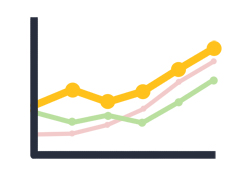Help Centre
Support > Website Performance > Universal Google Analytics
An Introduction To Site Statistics
 To fully understand the success of your website, and to discover which elements of it are working best when improving it, it's critical to study the statistics of your website when making business decisions. This practice is known as 'analytics'.
To fully understand the success of your website, and to discover which elements of it are working best when improving it, it's critical to study the statistics of your website when making business decisions. This practice is known as 'analytics'.
In order to get these statistics, you'll first need to add an analytics tool to your website. There are many free analytics tools available online that we'll be happy to attach to your site, but we have developed seamless integration with both Google Analytics and StatCounter to enable you to get the data you need with ease. The following guides will help you set these up for your Create website:
Simple or Complex, You Choose
Analytics can be as deep and detailed or as clear-cut as you want it to be. You can 'drill down' your statistics to discover how people use each and every page of your site, how long they spend there, or which of your online advertising campaigns is working the best.
Alternatively, if you fancy a broad overview, you can just take a look at how many people have visited your site, how many are returning visitors and what search terms or links people are using to find your site. With Google Analytics, you can even sit back and watch the activity on your site in real-time, as it happens.
As different web analytics tools offer slightly different statistics, we're not able to give you a detailed guide on how to use each one, but we can provide you with definitions of the most common terms you'll find when studying site statistics and provide some tips on how to use them. Combine this with your chosen tool's tutorials, you'll be well-placed to understand your website and how people use it in great detail, enabling you to improve your website and business and track the success of these improvements.
Analytics Terms
Here are definitions of some of the most common terms you'll find when you start your analytics.
- Hits: The number of times the web server requests a file from your website. This is not the same as visits, not by a long shot. As web pages can contain multiple files, when someone visits your website this can result in several hits. Do not use this figure to calculate how frequently visited your website is.
- Page view: The number of times a specific page has been seen. This figure does not reflect views of your website as a whole, rather the specific web page URL you’ve requested statistics about.
- Visit: A series of page views by a single visitor in one go. If the website records no activity on the website for 30 minutes, that visit is said to have ended (for example, if a visitor opens a new tab on their browser and leaves your website open but does not return to it for 30 mins). It’s important to remember that a visit (also known as a session) could consist of someone viewing one of your web page or hundreds of them. You could equate a visit to a customer’s browse through a high street shop – they could peer through the window or spend hours browsing, but both count as a visit.
- Visitor: Sometimes referred to as a unique visitor, this is not the same as the human viewing your website. A visitor is a combination of the particular computer they are using and the browser they are using. So, for example, if someone views your website on two different devices simultaneously, this would count as two visitors, as would that person viewing your website on two different browsers on the same computer. As this is very uncommon, ‘unique visitor’ is a reliable statistic to use to estimate the number of different people viewing your site.
- Single Page Visit: Also known as a ‘bounce’, this is a visit in which only a single web page is viewed. If you only have one web page or most of the information and content you want to provide to your visitors is on one page, then this statistic shouldn’t bother you.
- Bounce Rate: The percentage of visits that are single page visits; the percentage of visitors that are said to have ‘bounced’. This statistic is important in working out how successfully your website is drawing in its visitors and encouraging them to spend time browsing it. The lower the bounce rate, the more people you could say are effectively ‘browsing’ your website. The high street equivalent of bounce rate would be the percentage of people that peer through the shop window but don’t go in.
- New Visitor: As the name suggests, a unique visitor who has never before visited your website.
- Returning Visitor: A unique visitor who has previously visited to your site.
- Exit Rate: This is a statistic applied to a specific page. It’s the likelihood of this page being the last page a visitor views before leaving your site. If a page has a high Exit Rate, consider ensuring that links to other sites open in a new browser tab or improving the site navigation so the page encourages visitors to other areas of your site.
- Pages / Visit: The approximate ‘depth’ of visits to your site, meaning the average number of web pages viewed on a visit to your site.
Taking Action
Once you've familiarised yourself with your analytics tool, you can start putting these statistics to good use. Here are a few suggestions to get you started.
- Using a 'site visits over time' graph, you'll be able to find out which times of day and which days of the week your site is most popular, allowing you to coordinate any promotional or social media efforts you might be making.
- Take a look at your site's bounce rate to see how well it's doing keeping people browsing your site. A high bounce rate means people are taking a look at one page and leaving. Is there anything you could do to your site's design or content to minimise this?
- Learn about your audience by finding out where in the country (or indeed, the world) they are accessing your website from, what internet browsers are most popular among them and how many use mobile devices to get to your website.
- Use Page Load Times to check whether any of your pages are taking a very long time to load. If you have too much content on your page (such as lots of large, hi-resolution images) it may be slowing your site down and putting people off. Studies show that a slow-loading site reduces trust in a business, especially when it comes to e-commerce.
- Some tools, including Google Analytics, allow you to see the average 'journey' a site visitor makes through your site. Use this to improve links between pages and ensure that visitors are moving in the right direction (e.g. towards the checkout).
There is a huge amount of detailed information you can get about your site using analytics, and it's easy to feel overwhelmed by the sheer number of figures available. My advice is to start by picking the statistics that mean the most to your business, such as page views and site visits, and tracking these over time to get a picture of how well your site's working. Then you can start looking at separate pages to learn where to start improving your site.
Best of luck with your site stats!
Related Articles
More Questions?
If you have any further questions, please get in touch and we will be happy to help.
Get in Touch



